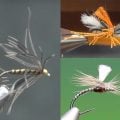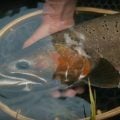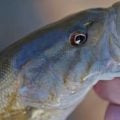How to Tie the Manhattan Midge
Producer: Tim Flagler
This is a variation of Forrest Dorsey’s Manhattan Midge, which is, in itself, an enhanced version of other patterns in the Dorsey family of flies.
What makes this version a little different is the red Umpqua U-Series, size 20 scud/pupa hook. Although the hook isn’t terribly small, plunger-style hackle pliers make handling them much easier. Just secure the shank in the hook of the pliers, like so.
You can then drag the hook through some midge-sized, silver Killer Caddis glass beads in hopes of catching one. With the bead on the hook, get the assembly firmly secured in the jaws of your tying vise and push the bead up to the hook eye.
For thread, I’m going to use UTC 70 Denier in red, but this pattern also looks really good in black. Think dressed-up Zebra midge. Get the thread started on the hook shank behind the bead and take a few wraps rearward before snipping off the excess tag.
Although the original pattern called for Glamour Madeira for the wing bud, the stuff can be a bit hard to find. But light pink, midge-sized Sparkle Braid is a good substitute. An inch-long segment is more than you really need. Secure the segment to the top of the hook shank and take a few wraps rearward to bind it down. Snip the rearward-pointing part of the braid off close. Continue taking thread wraps to cover up the butt end then go well down into the hook bend.
Extra-small, silver Ultra wire is used to rib and segment the fly, a 6” length will make numerous flies. Place one end of the wire against the near side of the hook and take thread wraps to secure it. Continue taking wraps up the shank, binding the wire down as you go. Once the wire’s bound down up to the braid, wind back down the shank with your tying thread, then back up to produce a lightly tapered body. Try to get the butt end of the braid covered up without adding too much bulk. Give your bobbin a counterclockwise spin to uncord and flatten the thread. This will allow you to fill in any dramatic lumps and bumps on the body. End with your tying thread right at the braid.
Get hold of the silver wire and start making open, spiral wraps with it to create the look of segmentation on the abdomen of the fly. When you reach your tying thread, use it to firmly anchor the wire then helicopter to break the excess off close.
Pull rearward on the braid and take thread wraps to pin it back on top of the abdomen. Take a few more thread wraps to create some space between the braid and the back edge of the bead.
A single peacock herl is used to produce the thorax of the fly. With the longer flues pointed down, snip an inch or two of the brittle tip off square. With the longer flues still pointing down, bind the herl to the near side of the hook using tight wraps of tying thread. You can then break or snip the excess off close. Start taking touching wraps forward with the herl to build up a fuzzy little thorax on the fly. When you reach the back edge of the bead, use your tying thread to anchor the herl, then break or snip the excess off close.
Reach for your whip finish tool and use it to do a 3 or 4 turn whip finish, seat the knot well and snip or cut your tying thread free. The final step is to trim the wing bud so it extends not quite to the back edge of the hook bend.
The Manhattan Midge, despite its diminutive size, includes a slew of proven fish-catching materials and features. This version, because of the red hook, probably should be called the Brooklyn Midge.
How to Tie the Major Woody
How to Tie the Minkie











